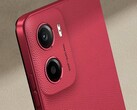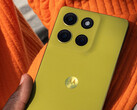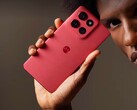Motorola Moto G86 5G verdict
The Motorola Moto G86 5G sets the standard for mid-range displays, with hardly any other smartphone priced around $350 offering this level of brightness. The color reproduction is also excellent, and its high resolution enables crisp images.
The high-quality chassis comes in a range of vibrant colors, and looks very attractive. It also now enjoys an IP rating.
On the other hand, however, the Wi-Fi and the SoC's performance are rather standard. While you can expect relatively smooth operation, the phone is hardly suitable for demanding tasks.
You can count on the camera to take good pictures, but it doesn't offer much in terms of flexibility. The battery lasts for a day of use, without standing out from other mid-range phones.
Overall, it's the bright and detailed screen as well as the attractive and sturdy case that make the Motorola Moto G86 special.
Pros
Cons
Price and availability
At the time of reviewing, the Moto G86 is unavailable to purchase on Amazon.
Table of Contents
- Motorola Moto G86 5G verdict
- Specifications
- Case – The Motorola phone is now IP-certified
- Features – Including eSIM and NFC
- Software – At least 4 years of updates
- Communication and GNSS – Sluggish WiFi 6
- Telephone functions and voice quality – Clear, but high-pitched
- Cameras – The Moto phone offers good image quality
- Accessories and warranty– Including a protective case
- Input devices and operation – Fast recognition
- Display – Almost no other display gets as bright
- Performance – Typical mid-range power
- Spiele – Gaming at 60fps
- Emissions – Pretty hot
- Battery life – The Moto G86 has great stamina
- Notebookcheck overall rating
- Possible alternatives compared
Motorola's Moto G series is a real bestseller worldwide. No wonder, since it hits the sweet spot between affordable prices, good features, and, for the past few years, great looks with Pantone colors and premium materials on the back.
The Moto G86 is currently the most expensive and best-equipped phone in the series available in Europe, and is priced at around $350.
However, Motorola must also be careful to maintain its distance from its Edge series: The Edge 60 Fusion is only slightly more expensive, yet it still aims to offer a high-end feel at a low price.
For this reason, it will be exciting to see how Motorola manages this balancing act with its new Moto G86.
Specifications
Case – The Motorola phone is now IP-certified
The Motorola Moto G86 might be a touch boring with its dark grey Spellbound colour variant, but with its light green, bright red or delicate purple faux leather backs, it can also be a colourful smartphone.
The chassis is of very high quality and impresses with its rubberized feel (the manufacturer calls it a "Soft Luxe Texture surface"). The phone fits nicely in the hand, and thanks to its weight of 185 grams, you can hold it for long periods without getting tired.
For the first time, the Moto G86 possesses an IP rating, which provides resistance to water and dust. Thanks to Gorilla Glass 7i, the screen is also well protected from damage and scratches.
Features – Including eSIM and NFC
With 8 GB of RAM and 256 GB of storage, the smartphone is adequately equipped for its price range, without setting any new standards. There's no microSD slot for memory expansion.
The USB port only supports the USB 2.0 protocol, meaning it doesn't offer particularly fast data transfers or wired image output to another monitor. However, you can wirelessly connect other smart TVs or PCs and run apps on the PC.
In addition to a nano-SIM slot, there's also support for an eSIM, allowing dual-SIM operation.
NFC for contactless payments is available and worked flawlessly in our tests.
Software – At least 4 years of updates
The Moto G86 comes preinstalled with Android 15. Motorola has made minimal changes to the system itself, outsourcing most of its own features to the Moto and Moto Secure apps. These include settings for design, gesture control, and other security settings.
Security updates are expected to be available until at least June 2029, approximately four years from the time of our review. When it comes to certification for the EU energy label, Motorola even makes claims of six years of updates.
Sustainability
The Moto G86 comes in a very slim, plastic-free package. Motorola states that the smartphone's recycled content is 14.17%.
The phone has received an "A" rating in the European Energy Certificate, and the battery is said to be easily replaceable by the user. In collaboration with replacebase.eu, Motorola also already offers spare parts and initial repair instructions for private users, but the Moto G86 is not yet included.
Communication and GNSS – Sluggish WiFi 6
The Motorola Moto G86 comes with Wi-Fi 6, the fastest Wi-Fi standard. However, you have to make do with 1x1 MIMO. This means there is only one antenna each in the transmit and receive directions. This results in data speeds of between 201 and 408 Mbps in our extensive test with the reference router, the Asus ROG Rapture AXE11000. Transmissions are quite stable.
Anyone wishing to access the mobile data network can also use the fast 5G network. There are enough frequency bands available to surf the internet even when abroad. However, you should check before travelling long distances, as not all frequencies are supported.
| Networking | |
| Motorola Moto G86 | |
| iperf3 transmit AXE11000 | |
| iperf3 receive AXE11000 | |
| Motorola Moto G85 | |
| iperf3 transmit AXE11000 | |
| iperf3 receive AXE11000 | |
| CMF Phone 2 Pro | |
| iperf3 transmit AXE11000 | |
| iperf3 receive AXE11000 | |
| Samsung Galaxy A26 5G | |
| iperf3 transmit AXE11000 | |
| iperf3 receive AXE11000 | |
| Motorola Edge 60 Fusion | |
| iperf3 transmit AXE11000 | |
| iperf3 receive AXE11000 | |
| Average 802.11 a/b/g/n/ac/ax | |
| iperf3 transmit AXE11000 | |
| iperf3 receive AXE11000 | |
| Average of class Smartphone | |
| iperf3 transmit AXE11000 | |
| iperf3 receive AXE11000 | |
Outdoors, you can be located very quickly with an accuracy of up to 3 meters. This is ensured by numerous satellites from a wide variety of positioning systems. However, for even higher accuracy, SBAS is not supported.
In our real-life test, a bike ride through a mix of open terrain and narrow old town alleys, the phone proved to be generally suitable for navigation. It only occasionally placed us slightly off the road and hardly showed any major errors, except shortly before crossing the bridge.
So, if you don't require perfect accuracy, you can mostly rely on the phone's positioning.
Telephone functions and voice quality – Clear, but high-pitched
Motorola uses the Google app for the smartphone's phone function. It's clear and offers all the necessary features.
The voice quality is decent, but the person on the other end of the phone sounds a bit high-pitched through the earpiece. However, we were clearly understood. The hands-free microphone and internal speaker also make phone calls easy: Our caller understood us well, and they were also clearly understood at our end.
Cameras – The Moto phone offers good image quality
On the rear, a 50-megapixel main camera provides the necessary image quality for capturing beautiful shots. The Moto G86 actually does quite a good job for a mid-range smartphone.
Even small details are often still visible. However, the depth of field effect in the flower photo seems odd. Ambient shots turn out well, and in low light, we like the fairly high dynamic range and good sharpness.
Videos can be recorded in a maximum of 4K and at 30fps. 60fps is also optionally available in Full HD. Shots turn out quite well even in poor lighting conditions, and the autofocus works reliably and is mostly discreet.
For wider-angle shots, there's an 8-megapixel sensor on the rear. This takes passable snapshots, but the details themselves are quite rough.
The front camera takes detailed selfies, but its dynamic range is somewhat weaker in dark areas.
Image comparison
Choose a scene and navigate within the first image. One click changes the position on touchscreens. One click on the zoomed-in image opens the original in a new window. The first image shows the scaled photograph of the test device.
Main camera plantMain camera environmentMain camera Low lightUltra-wide-angle cameraEven under laboratory conditions, the main camera delivers good results in full light. However, details lack sharpness.
At just one lux of light, nothing is visible.
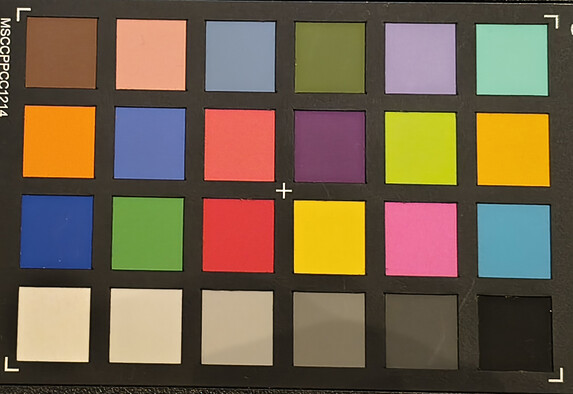

Accessories and warranty– Including a protective case
Motorola includes a matching hard plastic bumper with its phone, which even matches the color of the smartphone. A USB cable and a SIM card reader are also included in the package.
The manufacturer offers a 24-month warranty within the EU.
Input devices and operation – Fast recognition
The Moto G86's touchscreen responds quickly and reliably to inputs. It can display up to 120 frames per second, which means commands are executed very smoothly.
The fingerprint sensor is integrated underneath the display and, once trained, it recognizes fingerprints quickly and with high accuracy.
The front camera can be used for facial unlocking. This also works well, with the screen providing a useful light source in the dark. However, this method is not quite as secure and is often the reason for not being accepted for biometric unlocking by banking apps, for example.
Display – Almost no other display gets as bright
The Moto G86's P-OLED display offers a slightly higher resolution than its predecessor: 2,712 x 1,220 pixels in a 6.7-inch format. This results in a fairly high pixel density of 446 PPI and helps the device display very fine details.
The maximum brightness is also impressive: with the brightness sensor exposed to light, it reaches up to 1,456 cd/m², outperforming comparable devices. The manufacturer specifies up to 4,500 cd/m² as the maximum for smaller surfaces, and, in our test, we actually achieved up to 3,725 cd/m² at APL18. This also enables beautiful HDR images.
| |||||||||||||||||||||||||
Brightness Distribution: 89 %
Center on Battery: 1456 cd/m²
Contrast: ∞:1 (Black: 0 cd/m²)
ΔE ColorChecker Calman: 1.08 | ∀{0.5-29.43 Ø4.83}
ΔE Greyscale Calman: 1.4 | ∀{0.09-98 Ø5.1}
95.3% sRGB (Calman 2D)
Gamma: 2.234
CCT: 6405 K
| Motorola Moto G86 P-OLED, 2712x1220, 6.7" | Motorola Moto G85 P-OLED, 2400x1080, 6.7" | CMF Phone 2 Pro AMOLED, 2400x1080, 6.8" | Samsung Galaxy A26 5G Super AMOLED, 2340x1080, 6.7" | Motorola Edge 60 Fusion P-OLED, 2712x1200, 6.7" | |
|---|---|---|---|---|---|
| Screen | -13% | -25% | -114% | -25% | |
| Brightness middle | 1456 | 1207 -17% | 1280 -12% | 735 -50% | 1281 -12% |
| Brightness | 1362 | 1177 -14% | 1277 -6% | 731 -46% | 1281 -6% |
| Brightness Distribution | 89 | 94 6% | 97 9% | 99 11% | 94 6% |
| Black Level * | |||||
| Colorchecker dE 2000 * | 1.08 | 1.36 -26% | 1.3 -20% | 3.8 -252% | 1.47 -36% |
| Colorchecker dE 2000 max. * | 2.21 | 2.8 -27% | 3.9 -76% | 5.8 -162% | 3.14 -42% |
| Greyscale dE 2000 * | 1.4 | 1.4 -0% | 2 -43% | 4 -186% | 2.2 -57% |
| Gamma | 2.234 98% | 2.23 99% | 2.14 103% | 1.98 111% | 2.062 107% |
| CCT | 6405 101% | 6591 99% | 6776 96% | 6628 98% | 6628 98% |
* ... smaller is better
Screen Flickering / PWM (Pulse-Width Modulation)
| Screen flickering / PWM detected | 733 Hz Amplitude: 7 % | ||
The display backlight flickers at 733 Hz (worst case, e.g., utilizing PWM) . The frequency of 733 Hz is quite high, so most users sensitive to PWM should not notice any flickering. In comparison: 53 % of all tested devices do not use PWM to dim the display. If PWM was detected, an average of 8327 (minimum: 5 - maximum: 343500) Hz was measured. | |||
A series of measurements with a fixed zoom level and different brightness settings (The amplitude curve at minimum brightness appears flat, but this is due to the scaling. The info box shows the enlarged version of the amplitude at minimum brightness.)
We measured a significant flicker at 733 Hz and low brightness. This is likely due to DC dimming, which is intended to mitigate the PWM effect. In reality, such high-frequency flickering should be barely noticeable and not cause any problems even for users sensitive to such issues. When comparing the different brightness levels, we also observed only minor fluctuations.
Nevertheless, it may be advisable to test the monitor before purchasing, for example, in an electronics store if you have had problems with flickering screens in the past.
Display Response Times
| ↔ Response Time Black to White | ||
|---|---|---|
| 1.5 ms ... rise ↗ and fall ↘ combined | ↗ 0.7 ms rise | |
| ↘ 0.8 ms fall | ||
| The screen shows very fast response rates in our tests and should be very well suited for fast-paced gaming. In comparison, all tested devices range from 0.1 (minimum) to 240 (maximum) ms. » 7 % of all devices are better. This means that the measured response time is better than the average of all tested devices (20.5 ms). | ||
| ↔ Response Time 50% Grey to 80% Grey | ||
| 2 ms ... rise ↗ and fall ↘ combined | ↗ 1 ms rise | |
| ↘ 1 ms fall | ||
| The screen shows very fast response rates in our tests and should be very well suited for fast-paced gaming. In comparison, all tested devices range from 0.165 (minimum) to 636 (maximum) ms. » 8 % of all devices are better. This means that the measured response time is better than the average of all tested devices (32.1 ms). | ||
Performance – Typical mid-range power
With the MediaTek Dimensity 7300, Motorola has gone with an SoC that's currently very popular in the mid-range and also delivers adequate performance. Compared to its predecessor, the Moto G85, the phone improves in many benchmarks.
In most situations, it got us through everyday use smoothly in our tests. Only intensive multitasking or very demanding apps make the SoC sweat.
| UL Procyon AI Inference for Android - Overall Score NNAPI | |
| Motorola Moto G86 | |
| Motorola Edge 60 Fusion | |
| Average MediaTek Dimensity 7300 (8087 - 27964, n=7) | |
| Average of class Smartphone (1267 - 81594, n=142, last 2 years) | |
| Samsung Galaxy A26 5G | |
| Motorola Moto G85 | |
| AImark - Score v3.x | |
| Average of class Smartphone (82 - 307528, n=127, last 2 years) | |
| Average MediaTek Dimensity 7300 (13579 - 14587, n=3) | |
| Motorola Moto G86 | |
| Samsung Galaxy A26 5G | |
| Motorola Moto G85 | |
| Geekbench AI | |
| Single Precision TensorFlow NNAPI 1.4 | |
| Average of class Smartphone (231 - 1131, n=12, last 2 years) | |
| Average MediaTek Dimensity 7300 (518 - 584, n=3) | |
| Motorola Edge 60 Fusion | |
| Motorola Moto G86 | |
| Half Precision TensorFlow NNAPI 1.4 | |
| Average of class Smartphone (231 - 4555, n=12, last 2 years) | |
| Average MediaTek Dimensity 7300 (1266 - 1425, n=3) | |
| Motorola Edge 60 Fusion | |
| Motorola Moto G86 | |
| Quantized TensorFlow NNAPI 1.4 | |
| Average MediaTek Dimensity 7300 (2586 - 2915, n=3) | |
| Motorola Edge 60 Fusion | |
| Motorola Moto G86 | |
| Average of class Smartphone (133 - 4549, n=12, last 2 years) | |
| AI Benchmark - Score V6 | |
| Average of class Smartphone (68.9 - 12578, n=56, last 2 years) | |
| Motorola Edge 60 Fusion | |
| Average MediaTek Dimensity 7300 (232 - 581, n=6) | |
| Motorola Moto G86 | |
| Samsung Galaxy A26 5G | |
The GPU also packs enough power to run at the display's native resolution. However, rendering at 1440p or 4K is usually too demanding for smooth gaming.
For videos, however, you can also view 4K content smoothly, on video services such as YouTube.
GFXBench (DX / GLBenchmark) 2.7: T-Rex Onscreen | 1920x1080 T-Rex Offscreen
GFXBench 3.0: on screen Manhattan Onscreen OGL | 1920x1080 1080p Manhattan Offscreen
GFXBench 3.1: on screen Manhattan ES 3.1 Onscreen | 1920x1080 Manhattan ES 3.1 Offscreen
GFXBench: on screen Car Chase Onscreen | 1920x1080 Car Chase Offscreen | on screen Aztec Ruins High Tier Onscreen | 2560x1440 Aztec Ruins High Tier Offscreen | on screen Aztec Ruins Normal Tier Onscreen | 1920x1080 Aztec Ruins Normal Tier Offscreen | 3840x2160 4K Aztec Ruins High Tier Offscreen
| 3DMark / Wild Life Extreme Unlimited | |
| Motorola Edge 60 Fusion | |
| CMF Phone 2 Pro | |
| Motorola Moto G86 | |
| Samsung Galaxy A26 5G | |
| Motorola Moto G85 | |
| 3DMark / Wild Life Extreme | |
| Motorola Edge 60 Fusion | |
| Motorola Moto G86 | |
| CMF Phone 2 Pro | |
| Samsung Galaxy A26 5G | |
| Motorola Moto G85 | |
| 3DMark / Wild Life Unlimited Score | |
| CMF Phone 2 Pro | |
| Motorola Edge 60 Fusion | |
| Motorola Moto G86 | |
| Samsung Galaxy A26 5G | |
| Motorola Moto G85 | |
| 3DMark / Steel Nomad Light Unlimited Score | |
| Motorola Edge 60 Fusion | |
| Motorola Moto G86 | |
| Samsung Galaxy A26 5G | |
| 3DMark / Steel Nomad Light Score | |
| Motorola Edge 60 Fusion | |
| Motorola Moto G86 | |
| Samsung Galaxy A26 5G | |
| GFXBench (DX / GLBenchmark) 2.7 / T-Rex Onscreen | |
| Samsung Galaxy A26 5G | |
| Motorola Moto G85 | |
| Motorola Moto G86 | |
| Motorola Edge 60 Fusion | |
| GFXBench (DX / GLBenchmark) 2.7 / T-Rex Offscreen | |
| Samsung Galaxy A26 5G | |
| Motorola Edge 60 Fusion | |
| Motorola Moto G86 | |
| Motorola Moto G85 | |
| GFXBench 3.0 / Manhattan Onscreen OGL | |
| Samsung Galaxy A26 5G | |
| Motorola Moto G86 | |
| Motorola Edge 60 Fusion | |
| Motorola Moto G85 | |
| GFXBench 3.0 / 1080p Manhattan Offscreen | |
| Motorola Edge 60 Fusion | |
| Motorola Moto G86 | |
| Samsung Galaxy A26 5G | |
| Motorola Moto G85 | |
| GFXBench 3.1 / Manhattan ES 3.1 Onscreen | |
| Samsung Galaxy A26 5G | |
| Motorola Edge 60 Fusion | |
| Motorola Moto G86 | |
| Motorola Moto G85 | |
| GFXBench 3.1 / Manhattan ES 3.1 Offscreen | |
| Motorola Edge 60 Fusion | |
| Motorola Moto G86 | |
| Samsung Galaxy A26 5G | |
| Motorola Moto G85 | |
| GFXBench / Car Chase Onscreen | |
| Samsung Galaxy A26 5G | |
| Motorola Moto G86 | |
| Motorola Edge 60 Fusion | |
| Motorola Moto G85 | |
| GFXBench / Car Chase Offscreen | |
| Motorola Edge 60 Fusion | |
| Motorola Moto G86 | |
| Samsung Galaxy A26 5G | |
| Motorola Moto G85 | |
| GFXBench / Aztec Ruins High Tier Onscreen | |
| CMF Phone 2 Pro | |
| Samsung Galaxy A26 5G | |
| Motorola Edge 60 Fusion | |
| Motorola Moto G86 | |
| Motorola Moto G85 | |
| GFXBench / Aztec Ruins High Tier Offscreen | |
| CMF Phone 2 Pro | |
| Motorola Edge 60 Fusion | |
| Motorola Moto G86 | |
| Samsung Galaxy A26 5G | |
| Motorola Moto G85 | |
| GFXBench / Aztec Ruins Normal Tier Onscreen | |
| CMF Phone 2 Pro | |
| Samsung Galaxy A26 5G | |
| Motorola Edge 60 Fusion | |
| Motorola Moto G86 | |
| Motorola Moto G85 | |
| GFXBench / Aztec Ruins Normal Tier Offscreen | |
| CMF Phone 2 Pro | |
| Motorola Edge 60 Fusion | |
| Motorola Moto G86 | |
| Samsung Galaxy A26 5G | |
| Motorola Moto G85 | |
| GFXBench / 4K Aztec Ruins High Tier Offscreen | |
| CMF Phone 2 Pro | |
| Motorola Edge 60 Fusion | |
| Motorola Moto G86 | |
| Samsung Galaxy A26 5G | |
| Motorola Moto G85 | |
When surfing the internet, pages usually load fairly quickly. However, the immediate feeling you get when accessing pages with high-end phones is absent.
| Jetstream 2 | |
| 2.0 Total Score | |
| Average of class Smartphone (13.8 - 387, n=154, last 2 years) | |
| Samsung Galaxy A26 5G (Chrome 135.0.7049.111) | |
| CMF Phone 2 Pro (Chrome 137) | |
| Motorola Moto G85 (Chrome 127) | |
| Average MediaTek Dimensity 7300 (60.2 - 115.1, n=6) | |
| 2.2 Total Score | |
| Average of class Smartphone (56.4 - 401, n=24, last 2 years) | |
| Motorola Moto G86 (Chrome 138) | |
| Average MediaTek Dimensity 7300 (116.9 - 123.5, n=3) | |
| Samsung Galaxy A26 5G (Chrome 135.0.7049.111) | |
| Motorola Edge 60 Fusion (Chrome 135) | |
| Speedometer 2.0 - Result | |
| Average of class Smartphone (15.2 - 585, n=137, last 2 years) | |
| Motorola Edge 60 Fusion (Chrome 135) | |
| Samsung Galaxy A26 5G (Chrome 135.0.7049.111) | |
| Motorola Moto G86 (Chrome 138) | |
| Average MediaTek Dimensity 7300 (76.5 - 138, n=6) | |
| Motorola Moto G85 (Chrome 127) | |
| Speedometer 3.0 - Score | |
| Average of class Smartphone (1.03 - 34, n=105, last 2 years) | |
| Samsung Galaxy A26 5G (Chrome 135.0.7049.111) | |
| Motorola Moto G86 (Chrome 138) | |
| Motorola Edge 60 Fusion (Chrome 135) | |
| Average MediaTek Dimensity 7300 (5.6 - 8.72, n=7) | |
| Motorola Moto G85 (Chrome 127) | |
| WebXPRT 4 - Overall | |
| Average of class Smartphone (22 - 273, n=149, last 2 years) | |
| Samsung Galaxy A26 5G (Chrome 135.0.7049.111) | |
| Motorola Edge 60 Fusion (Chrome 135) | |
| Motorola Moto G86 (Chrome 138) | |
| Average MediaTek Dimensity 7300 (56 - 118, n=7) | |
| Motorola Moto G85 (Chrome 127) | |
| Octane V2 - Total Score | |
| Average of class Smartphone (2228 - 100368, n=204, last 2 years) | |
| CMF Phone 2 Pro (Chrome 137) | |
| Samsung Galaxy A26 5G (Chrome 135.0.7049.111) | |
| Motorola Edge 60 Fusion (Chrome 135) | |
| Motorola Moto G86 (Chrome 138) | |
| Motorola Moto G85 (Chrome 127) | |
| Average MediaTek Dimensity 7300 (22739 - 40600, n=11) | |
| Mozilla Kraken 1.1 - Total | |
| Average MediaTek Dimensity 7300 (1060 - 2154, n=7) | |
| Average of class Smartphone (277 - 28190, n=158, last 2 years) | |
| Motorola Moto G85 (Chrome 127) | |
| Motorola Moto G86 (Chrome 138) | |
| Motorola Edge 60 Fusion (Chrome 135) | |
| Samsung Galaxy A26 5G (Chrome 135.0.7049.111) | |
* ... smaller is better
Using faster UFS 2.2 flash than its predecessor also pays off. Data transfers and loading times are a bit faster.
| Motorola Moto G86 | Motorola Moto G85 | CMF Phone 2 Pro | Samsung Galaxy A26 5G | Motorola Edge 60 Fusion | Average 256 GB UFS 2.2 Flash | Average of class Smartphone | |
|---|---|---|---|---|---|---|---|
| AndroBench 3-5 | -22% | 11% | -47% | 13% | -3% | 81% | |
| Sequential Read 256KB | 980.4 | 529.8 -46% | 986.43 1% | 528.54 -46% | 967.4 -1% | 921 ? -6% | 2158 ? 120% |
| Sequential Write 256KB | 687.1 | 525.3 -24% | 524.58 -24% | 251.43 -63% | 908.8 32% | 734 ? 7% | 1749 ? 155% |
| Random Read 4KB | 219.3 | 220.7 1% | 294.62 34% | 219.57 0% | 272.1 24% | 230 ? 5% | 294 ? 34% |
| Random Write 4KB | 295.2 | 237 -20% | 385.68 31% | 61.8 -79% | 286.9 -3% | 248 ? -16% | 336 ? 14% |
Spiele – Gaming at 60fps
Smooth gaming is possible with the Moto G86 as long as you don't have excessive demands regarding detail. In PUBG Mobile, a fairly stable 60fps is achievable, but you have to reduce the rendering quality to a minimum.
Genshin Impact is a bit more demanding, but you can still play at a fairly stable 40fps on high details.
We tested the frame rates with software from GameBench.
Emissions – Pretty hot
Temperature
The Moto G86 heated up to 50.4°C in our long-term load test. This was quite noticeable, since we made our measurements at room temperature. On hot days, this temperature rise will increase even further.
However, this temperature rise doesn't seem to affect the SoC's performance. In the long-term 3DMark tests, we noticed only minimal performance losses.
(-) The maximum temperature on the upper side is 50.4 °C / 123 F, compared to the average of 35.1 °C / 95 F, ranging from 21.9 to 63.7 °C for the class Smartphone.
(-) The bottom heats up to a maximum of 49.6 °C / 121 F, compared to the average of 33.9 °C / 93 F
(+) In idle usage, the average temperature for the upper side is 28.9 °C / 84 F, compared to the device average of 32.9 °C / 91 F.
3DMark Steel Nomad Stress Test
| 3DMark | |
| Wild Life Stress Test Stability | |
| Motorola Moto G85 | |
| Motorola Moto G86 | |
| Motorola Edge 60 Fusion | |
| CMF Phone 2 Pro | |
| Samsung Galaxy A26 5G | |
| Wild Life Extreme Stress Test | |
| Motorola Moto G86 | |
| Samsung Galaxy A26 5G | |
| Motorola Edge 60 Fusion | |
| Motorola Moto G85 | |
| Steel Nomad Light Stress Test Stability | |
| Motorola Edge 60 Fusion | |
| Motorola Moto G86 | |
| Samsung Galaxy A26 5G | |
Speakers
The earphone supports the dedicated speaker, allowing for a slight stereo effect when holding the phone horizontally. The speakers can be quite loud, with the sound remaining reasonably clear.
It's generally an enjoyable experience to listen to music or movie soundtracks, even if the bass is definitely lacking.
External playback devices can be connected via USB-C or Bluetooth, which works seamlessly. Every common Bluetooth codec is integrated, which means wireless connections usually work well.
Motorola Moto G86 audio analysis
(+) | speakers can play relatively loud (87.1 dB)
Bass 100 - 315 Hz
(-) | nearly no bass - on average 23.8% lower than median
(±) | linearity of bass is average (11.6% delta to prev. frequency)
Mids 400 - 2000 Hz
(±) | higher mids - on average 6.1% higher than median
(+) | mids are linear (5.5% delta to prev. frequency)
Highs 2 - 16 kHz
(+) | balanced highs - only 3.2% away from median
(+) | highs are linear (4% delta to prev. frequency)
Overall 100 - 16.000 Hz
(±) | linearity of overall sound is average (19.8% difference to median)
Compared to same class
» 29% of all tested devices in this class were better, 8% similar, 63% worse
» The best had a delta of 12%, average was 36%, worst was 134%
Compared to all devices tested
» 49% of all tested devices were better, 7% similar, 44% worse
» The best had a delta of 4%, average was 24%, worst was 134%
Motorola Edge 60 Fusion audio analysis
(+) | speakers can play relatively loud (86.7 dB)
Bass 100 - 315 Hz
(-) | nearly no bass - on average 24.2% lower than median
(±) | linearity of bass is average (10.6% delta to prev. frequency)
Mids 400 - 2000 Hz
(±) | reduced mids - on average 6% lower than median
(+) | mids are linear (6% delta to prev. frequency)
Highs 2 - 16 kHz
(+) | balanced highs - only 2.9% away from median
(+) | highs are linear (3.7% delta to prev. frequency)
Overall 100 - 16.000 Hz
(±) | linearity of overall sound is average (17.8% difference to median)
Compared to same class
» 13% of all tested devices in this class were better, 8% similar, 79% worse
» The best had a delta of 12%, average was 36%, worst was 134%
Compared to all devices tested
» 34% of all tested devices were better, 8% similar, 58% worse
» The best had a delta of 4%, average was 24%, worst was 134%
Battery life – The Moto G86 has great stamina
Power consumption
The Motorola Moto G86 isn't quite as easygoing when it comes to power consumption. It consumes 1.4 watts in idle mode, but this can rise to 2.5 watts - a figure significantly higher than its competitors. Under load, consumption is then at a medium level.
The Moto G86 can only be charged via a wired charger, at a maximum of 30 watts. In our test, it took about 2 hours for the battery to complete a full charging cycle.
| Off / Standby | |
| Idle | |
| Load |
|
Key:
min: | |
| Motorola Moto G86 5200 mAh | Motorola Moto G85 5000 mAh | CMF Phone 2 Pro 5000 mAh | Samsung Galaxy A26 5G 5000 mAh | Motorola Edge 60 Fusion 5200 mAh | Average MediaTek Dimensity 7300 | Average of class Smartphone | |
|---|---|---|---|---|---|---|---|
| Power Consumption | 28% | 19% | -5% | 31% | 20% | -0% | |
| Idle Minimum * | 1.4 | 1 29% | 1.04 26% | 1.17 16% | 1 29% | 1.008 ? 28% | 0.868 ? 38% |
| Idle Average * | 1.6 | 1.2 25% | 1.63 -2% | 1.94 -21% | 1.3 19% | 1.438 ? 10% | 1.426 ? 11% |
| Idle Maximum * | 2.5 | 1.4 44% | 1.69 32% | 2.03 19% | 1.6 36% | 1.674 ? 33% | 1.588 ? 36% |
| Load Average * | 4.7 | 3.4 28% | 4.31 8% | 2.9 38% | 3.74 ? 20% | 7.17 ? -53% | |
| Load Maximum * | 8.1 | 6.8 16% | 11.79 -46% | 5.6 31% | 7.49 ? 8% | 10.8 ? -33% |
* ... smaller is better
Power consumption: Geekbench (150 cd/m²)
Power consumption: GFXbench (150 cd/m²)
Battery runtime
Motorola's slight increase in the battery capacity of its phone is likely due to the bright screen and slightly higher resolution. It now offers a 5,200 mAh battery compared to the 5,000 mAh housed in its predecessor.
The battery life is impressive, but in practice, you'll probably only notice minor differences compared to other mid-range phones. One exception is the Samsung Galaxy A26 5G, which offers significantly shorter battery life.
The Motorola Moto G86 achieved 17 hours and 18 minutes in our Wi-Fi test, which should easily get you through a day of normal use.
| Motorola Moto G86 5200 mAh | Motorola Moto G85 5000 mAh | CMF Phone 2 Pro 5000 mAh | Samsung Galaxy A26 5G 5000 mAh | Motorola Edge 60 Fusion 5200 mAh | |
|---|---|---|---|---|---|
| Battery Runtime | -7% | 5% | -14% | 1% | |
| Reader / Idle | 2066 | 1974 -4% | 1987 -4% | 1966 -5% | |
| H.264 | 1208 | 1114 -8% | 1122 -7% | 1161 -4% | |
| WiFi v1.3 | 1038 | 894 -14% | 1095 5% | 739 -29% | 1023 -1% |
| Load | 295 | 286 -3% | 249 -16% | 329 12% |
Notebookcheck overall rating

The Motorola Moto G86 5G is a great-looking smartphone with a very bright display.
The Wi-Fi could be faster, but overall, it's a good mid-range phone.
Motorola Moto G86
- 07/25/2025 v8
Florian Schmitt
Possible alternatives compared
Image | Model / Review | Price | Weight | Drive | Display |
|---|---|---|---|---|---|
| Motorola Moto G86 MediaTek Dimensity 7300 ⎘ ARM Mali-G615 MP2 ⎘ 8 GB Memory, 256 GB UFS 2.1 | Amazon: $442.12 List Price: 299€ | 185 g | 256 GB UFS 2.2 Flash | 6.67" 2712x1220 446 PPI P-OLED | |
| Motorola Moto G85 Qualcomm Snapdragon 6s Gen 3 ⎘ Qualcomm Adreno 619 ⎘ 12 GB Memory, 256 GB UFS 2.1 | Amazon: $199.50 List Price: 349€ | 171 g | 256 GB UFS 2.2 Flash | 6.67" 2400x1080 405 PPI P-OLED | |
| CMF Phone 2 Pro MediaTek Dimensity 7300 ⎘ ARM Mali-G615 MP2 ⎘ 8 GB Memory, 256 GB UFS 2.1 | Amazon: 1. $6.95 Mr.Shield Screen Protector c... 2. $7.99 Suttkue for CMF Phone 2 Pro ... 3. $47.00 CMF BY NOTHING CMF Buds Pro ... List Price: 279€ | 185 g | 256 GB UFS 2.2 Flash | 6.77" 2400x1080 389 PPI AMOLED | |
| Samsung Galaxy A26 5G Samsung Exynos 1380 ⎘ ARM Mali-G68 MP5 ⎘ 6 GB Memory, 128 GB | Amazon: 1. $3.99 Bencuku (2 Pack) Designed fo... 2. $5.95 Mr.Shield Screen Protector c... 3. $6.30 ivoler 2 Pack Tempered Glass... List Price: 299€ | 200 g | 128 GB UFS 3.1 Flash | 6.70" 2340x1080 385 PPI Super AMOLED | |
| Motorola Edge 60 Fusion MediaTek Dimensity 7300 ⎘ ARM Mali-G615 MP2 ⎘ 8 GB Memory, 256 GB UFS 2.1 | Amazon: 1. $6.85 Natbok 2 Pack 3D Compatible ... 2. $6.99 Aiziki 2 Pack for Motorola E... 3. $6.59 Anoowkoa 2 pack for Moto Edg... List Price: 329€ | 178 g | 256 GB UFS 2.2 Flash | 6.67" 2712x1200 445 PPI P-OLED |
Transparency
The selection of devices to be reviewed is made by our editorial team. The test sample was provided to the author as a loan by the manufacturer or retailer for the purpose of this review. The lender had no influence on this review, nor did the manufacturer receive a copy of this review before publication. There was no obligation to publish this review. We never accept compensation or payment in return for our reviews. As an independent media company, Notebookcheck is not subjected to the authority of manufacturers, retailers or publishers.
This is how Notebookcheck is testing
Every year, Notebookcheck independently reviews hundreds of laptops and smartphones using standardized procedures to ensure that all results are comparable. We have continuously developed our test methods for around 20 years and set industry standards in the process. In our test labs, high-quality measuring equipment is utilized by experienced technicians and editors. These tests involve a multi-stage validation process. Our complex rating system is based on hundreds of well-founded measurements and benchmarks, which maintains objectivity. Further information on our test methods can be found here.















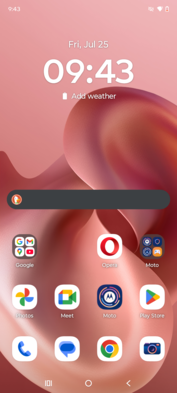

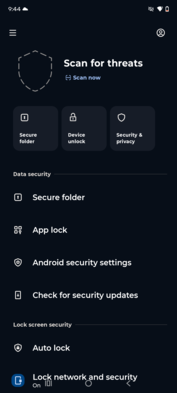
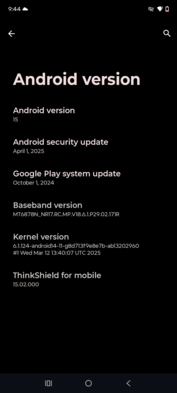
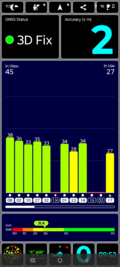
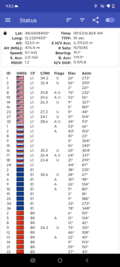

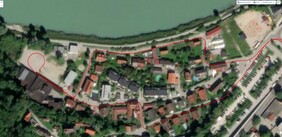
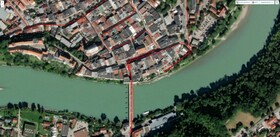
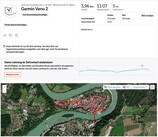
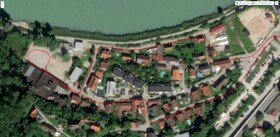
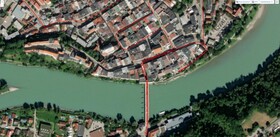


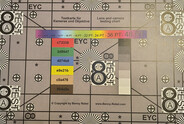



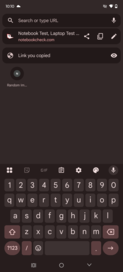
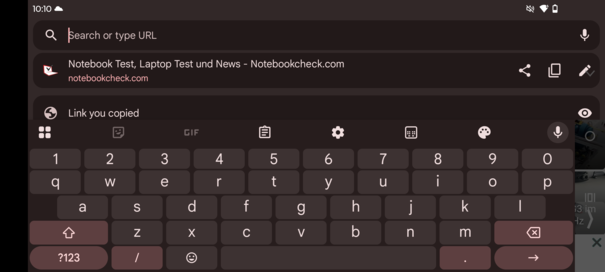







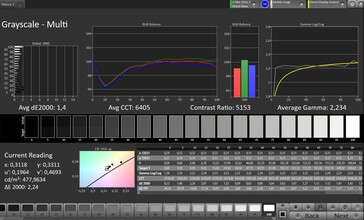
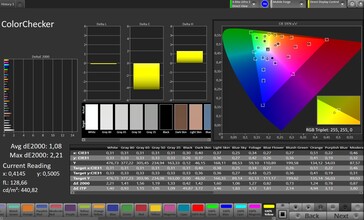
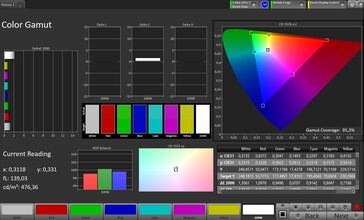

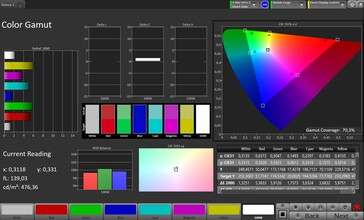
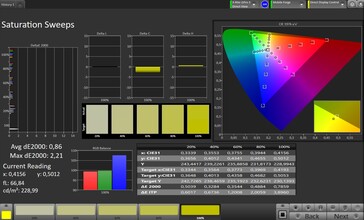
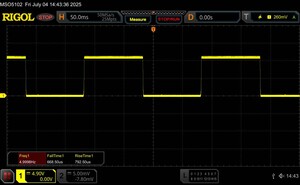
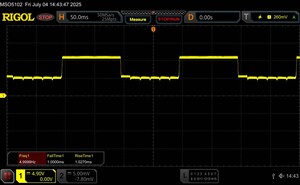
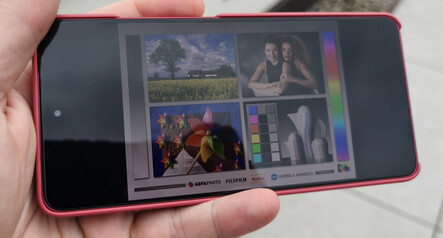

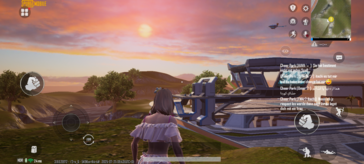

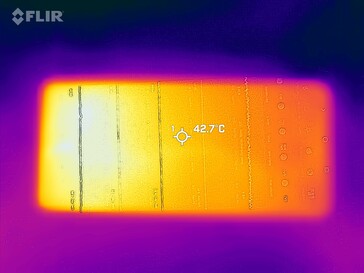
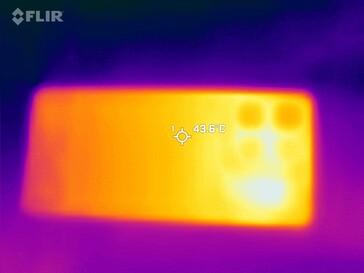
 Total Sustainability Score:
Total Sustainability Score: 




